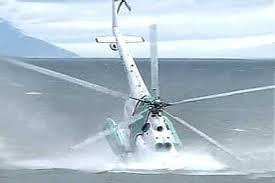On June 13, 2006, a joint Russian-Japanese search-and-rescue exercise turned tragic when a Russian Mi-14 helicopter crashed into the Sea of Japan off the coast of Sakhalin Island. The incident occurred during a rare military collaboration between the two countries aimed at improving emergency response and fostering goodwill. Of the 13 people aboard the aircraft, one crew member was confirmed dead while 12 others survived, many of them rescued in dramatic fashion by nearby naval and rescue units.
The Mil Mi-14, a Soviet-designed amphibious helicopter used by Russian naval forces, was participating in a planned rescue operation simulation, part of a larger bilateral effort known as “SAREX” (Search and Rescue Exercise). These drills were intended to improve coordination in maritime emergencies, particularly in the treacherous waters separating Japan and Russia.
The crash occurred when the Mi-14 attempted to perform a water landing as part of the exercise. According to initial reports, the helicopter suddenly lost stability and slammed into the water, flipping over shortly after impact. Rescue teams, including Japanese naval vessels and Russian emergency services, responded within minutes. Thanks to the swift action of these units, 12 of the 13 personnel aboard were pulled from the water alive. However, one crew member succumbed to injuries, despite efforts to resuscitate him at the scene.
This incident cast a temporary shadow over what had been a historic joint effort. Russia and Japan, despite a complex and often tense post-World War II relationship—complicated by territorial disputes over the Kuril Islands—had been working to strengthen mutual cooperation in non-military domains such as disaster response and marine safety. The 2006 exercise marked a notable step in that direction, with both nations deploying naval, air, and medical units for a carefully coordinated rescue drill.
Russian defense officials quickly launched an investigation into the cause of the crash. Preliminary analysis pointed to mechanical failure or pilot error, though no definitive conclusion was released immediately. The Mi-14, while reliable, is an aging aircraft, with many units dating back to the 1970s and 80s. The incident raised questions about the continued use of older military hardware in high-risk training scenarios.
Japanese officials expressed condolences and offered full cooperation in the aftermath of the crash. The Japanese Maritime Self-Defense Force provided support during and after the rescue, including medical attention for the survivors and logistical help in the recovery operation. The joint response showcased how, despite longstanding diplomatic tensions, the two nations could work side by side in times of crisis.
While the loss of life was deeply felt, the successful rescue of the majority of those on board was credited to the professionalism and preparedness of both Russian and Japanese forces. In a joint statement, military representatives reaffirmed their commitment to ongoing cooperation in humanitarian and disaster-related operations, emphasizing that such drills, though not without risk, are crucial for saving lives in real emergencies.
In the years following the crash, Russia and Japan have continued periodic rescue and disaster response drills, though with increased caution and enhanced safety measures. The 2006 Mi-14 crash remains a somber reminder of the risks inherent in even simulated operations—but also a testament to the potential of international collaboration in life-saving efforts.


Comments
Post a Comment